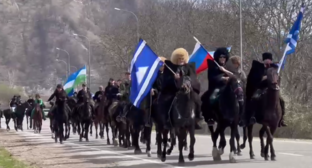02 June 2003, 12:17
The Khanaligs
They call themselves khinalugs, kattiddur (?village-mates?). A nation in Azerbaijan, the inhabitants of a mountainous village Khinalig (located at the height of over 2,3 thousand meters over the sea level). The researchers often unite Khanaligs with Budugs and Krizs into a ?shakhdag? group (from the name of the mountain Shakhdag around which theses peoples live); their culture is close to that of Azerbaijan. They speak Khanalig (Khinalug) language of the Lezghin sub-group of the Nakh-Dagestan group of the North Caucasus family. Russian and Azerbaijan languages are also common. Religious people are Moslems-sunnites.
Khinaligs are the successors of the population of the ancient Caucasus Albania, but they were first mentioned in the written sources in the 18th century. Before the 19th century the village society Khinalig was part of the Shemakhin (since the second half of the 18th century - the Kubin) khanate.
Traditional occupation - distant-pasture cattle-breeding (mainly sheep-breeding). In June - September the cattle was kept on the mountain pastures around Khinalig, in winter it was moved to the valley. Agriculture was a by-trade. They planted barley, rye, lintel, made terraces on the slopes for the crops. In 1930-ies they started to grow cabbages and potatoes. Trades - making wool fabrics (shal), knitted wool socks (jorab), one-colored felts (keche), ropes made of goat wool.
Khinalig is a typical mountain village with stone houses located on terraces. Stone houses have two floors, they are cemented with clay. The flat roof was covered with earth. The floor was covered with clay, instead of the windows there were small outlets with no glass. The second floor had the living rooms (with a room for the guests), the first floor was for the cattle. In the living room there was an open hearth (tunor) with an outlet over it for the light and smoke; there were also fireplaces.
Traditional costume of Khinaligs is similar to that of Azerbaijan. Female head gear was different. They consisted of five kerchiefs of different size and color (white and red colors were obligatory). The clothes of the older women were a bit different.
Khinalids? food was mainly dairy products: cheese (made of cow and goat milk), milk, sour milk matson; bread was baked using a mixture of barley and wheat flour, wild herbs were widely used, holiday dishes were boiled meat and pilav made of rice and beans. Traditional drinks - sherbet (water with honey), tea made of wild herbs.
Until the collectivization the social life of Khinalids retained the remnants of patriarchal-tribal relations (vendetta, mutual help, hospitality, lulech betrothal). The family relations were strictly endogamic: they preferred to marry cousins. The marriage took place by the will of the parents with the payment of the ransom - cattle (rams), rice, sometimes money. There were the customs of avoiding: for 2-3 years the daughter-in-law didn?t speak to the father-in-law, the elder brothers of the husband and his uncles on the father?s side (with the mother-in-law the time of avoiding was shorter).
Traditional culture of Khinaligs was greatly influenced by the culture of Azerbaijan (mainly in clothes and food).





Комментирование через Кавказский узел